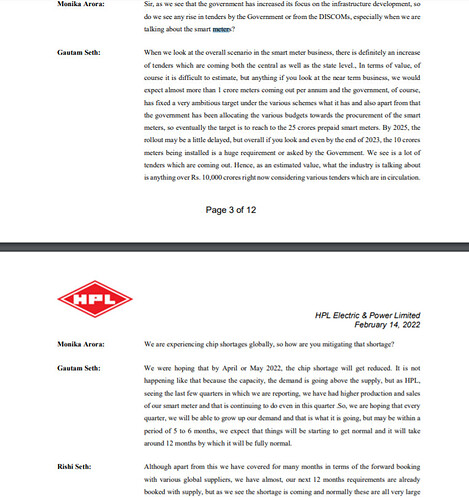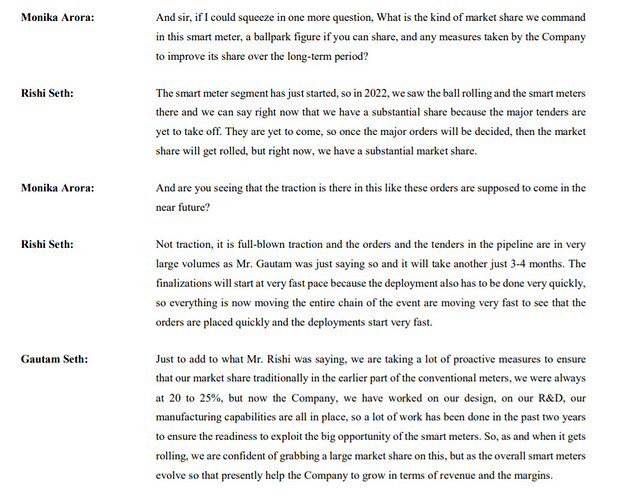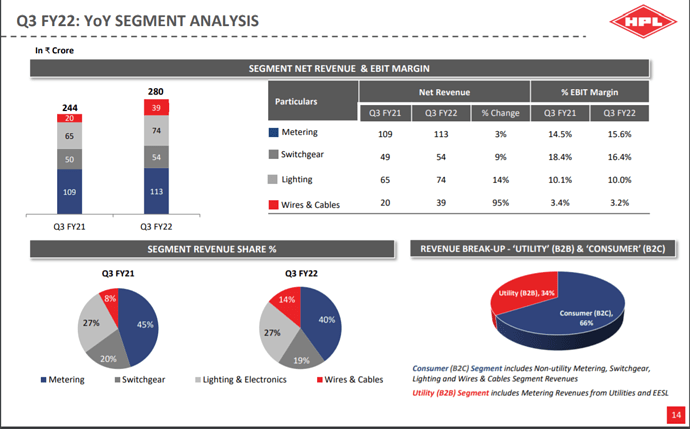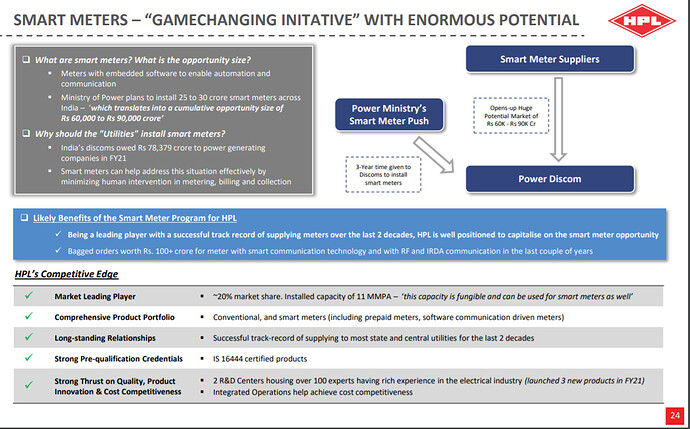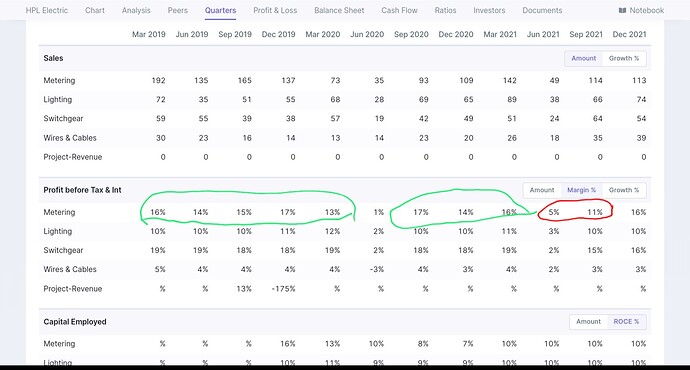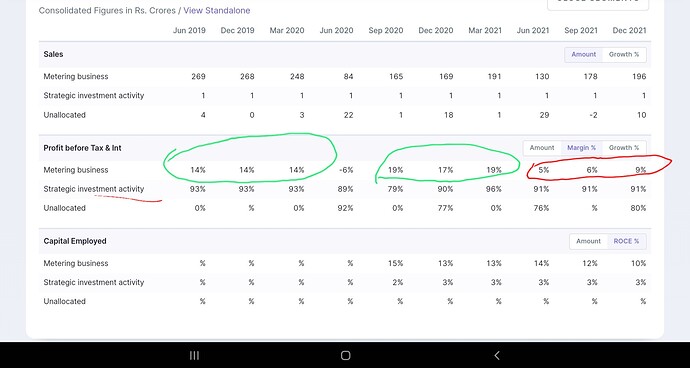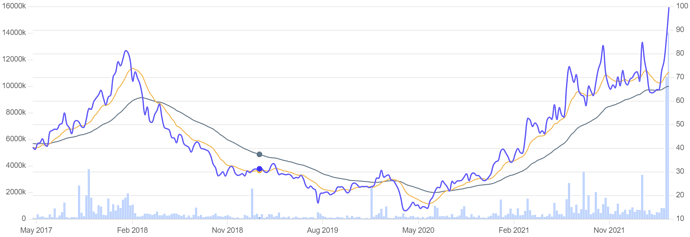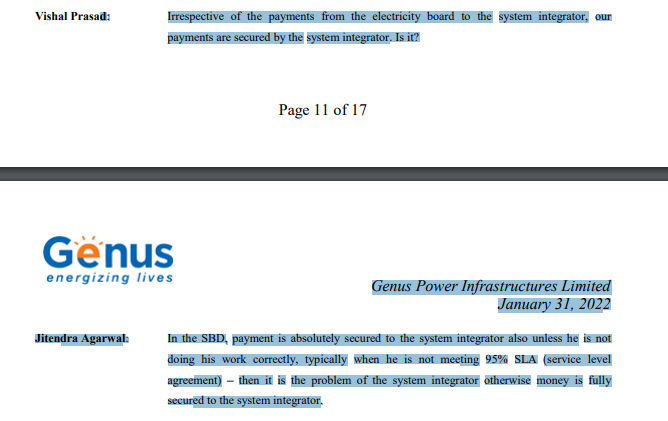Last Concal Extracts:
Capacity utilization is around 40% to 50% in the current times due to the shortage of raw material and what we feel the way we have done the planning in last two quarters and the
way that things are getting normal every day - by the end of June I would say second quarter of the next financial year capacity utilization will start getting better, will start
reaching the normalized phase from July end. Once the capacity utilization gets normalized
the margins will also get better than previous levels but it will be from Q3 or Q4.
**The tenders are highest ever historically.**So if I talk of as on date, , we have almost Rs.
13,000 Crores tender which are in the pipeline out of which almost Rs. 1,800 Crores has
been quoted and Rs. 7,000 crore tenders will be quoted in the next two to three months. And
even the order pipeline if you see the industry wise, like we got some orders from
Jharkhand, from private utilities, we have got some good order booking in last quarter and
this quarter also order booking will have some good numbers. Same way the industry wide
also you will see very good order booking. Otherwise also like EESL, they got an order of
Rs. 600 Crores from Assam. So now they have come out with a tender in the market where
they will buy meters. So order booking has also started from the State Electricity Boards to
system integrators like IntelliSmart. InAndhra Pradesh AP Board have given orders, so
again the tenders will be floated in the market to buy meters. When the order booking from
the SEBs has also started, from system integrators to people like us has also started. And
Genus plays both the roles that of system integrator and also a major supplier also. So we
are getting orders from both the works.
We have been maintaining this in the past also that we have enough capacity to take care of the requirements and enhancement of capacity for a company like Genus
because they are so well vertically integrated - currently we have a capacity of 10 million
meters to 12 million meters annually, and to reach to the level of 16 million to 20 million
meters annually, it is a matter of three to six months. So what I believe is from the next
calendar year onwards, we should be in a position where we are able to do 100% capacity
utilization, and then we can add on to our capacities. So thus we have planned internally
from May, June onwards looking into the way the industry is moving, we will start working
on our capacity expansion if required
According to the bid, according to our need of the bid we are making the participation. Like
in Andhra we are working with the system integrator - we were very clear that we are not
putting the application. In Assam we quoted directly also and EESL also quoted. And EESL
is using our meters in the bid. So all kinds of strategies are being worked out in the market.Genus has a very flexible approach. We are working with system integrators as their
suppliers and we are also doing some of the projects directly as system integrators.
Mohit Kumar: How is the competition in the system? Has it increased? Is it increasing given the expected
large opportunity - of course it had not materialized as of now but FY2023 could be a very,
very big year for the entire industry?
Jitendra Agarwal: Competition will always be there. It is the important part is how well you are prepared for
the competition and fortunately Genus is sitting in the sweet spot where we are prepared
ourselves and also are very well prepared to take onslaught of any kind of competition.
Vishal Prasad: Thank you. Good afternoon. I have a few questions. I understand we have not won any
orders in capex plus opex model up till now. But Sir could you probably spend two minutes
to explain the modalities of the contract, the capex plus opex, how does it work and how
does the payment works, how are the capabilities of different vendors is taken into
consideration while giving the contract?
Jitendra Agarwal: The capex model is very simple - mostly as a system integrator we have to bid of per meter
per month and this we have to maintain for ten years. 2 to 2.5 years are given for the
installation, and 7.5 to 8 years are given for the maintenance. So total for ten years the
whole project will be under the system integrator, where the system integrator will do the
end-to-end job from installation of meters to maintaining the daily SMS, monthly SMS and
quarterly SMS, everything will be done by the system integrator. SMS means service level
agreement which will be done between the electricity boards and the system integrators and
mostly the system integrator will be paid by per meter per month. So this is how the whole
system will work – not only from the meter reading, billing and in some cases they are
even talking of collection - everything is managed by the system integrator. So the end-toend solution of metering will be taken care by the system integrators, which is EESL is
doing currently… So this is how the whole system is going to work.
Vishal Prasad: Last question if we have to compare our capabilities in software with our competitors so let
us say for example L&T sold it to one of the multinationals - so could you elaborate on
what are the advantages that we have with respect to our multinational competitors and
what are the areas where we are lacking and we will still have to catch up?
Jitendra Agarwal: Currently Genus is the only company which is providing end-to-end solutions. I do not say
that others are not capable of providing that - but they are still little behind us in providing
end-to-end solutions in the current state of affairs and we are probably the only company
which is working in all the communication spheres. So I think technically if you want to
compare with Schneider we are much more vertically integrated in comparison to
Schneider. I do not say that these are not good companies. They are all very good
companies. There is competition, but currently when it comes to smart meters, we have an
edge over them.
Nikhil Jain: Second thing is that in one of the earlier calls you suggested that there are something like 90
to 100 people who are working in the R&D side, who are working in doing the
development work for the smart meter. So if you can just give a little more idea about what
they actually do and what is the value add that is coming in from there? How is it different
from let us say a commodity kind of a product right that’s available off the shelf so based on
the work that the team is doing? So if you can just give some perspective that will be very
helpful? Thank you.
Jitendra Agarwal: Meter being a very custom-built product, it needs a lot of customization according to the
customer requirement. Just to give you a simple example like in doing a smart meter project
in a city like Jaipur, the end customer is concerned about the SLA (service level agreement).
He is not much concerned that how we are going to get to the data. So for him the most
important is to meet the SLA. We are currently working in Jaipur, what we have seen in
Jaipur, is we are using all the technologies, in some places we are using others for
communicating, in some places they are using GPRS. Genus has the capability looking to
the condition of the geography, because we are vertically integrated, we have our own
design. We are not dependent on others for design of the product. We have almost 300
engineers in the R&D (not just 90 to 100) just to give you a perspective - we are very solid
in terms of R&D. And it is not only when we talk about smart meters, it is not only about
hardware, there is a lot of embedded software, which goes into this. It is the only electronic
product in the world which has an electrical application. This is where people have to
understand is that smart meters meters, will never become a commodity and I am confident.
Strong tailwind for the Company and it seems that the Smart meter business is at an inflection point.
Disclosure : Invested at levels of 90.


